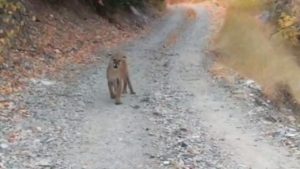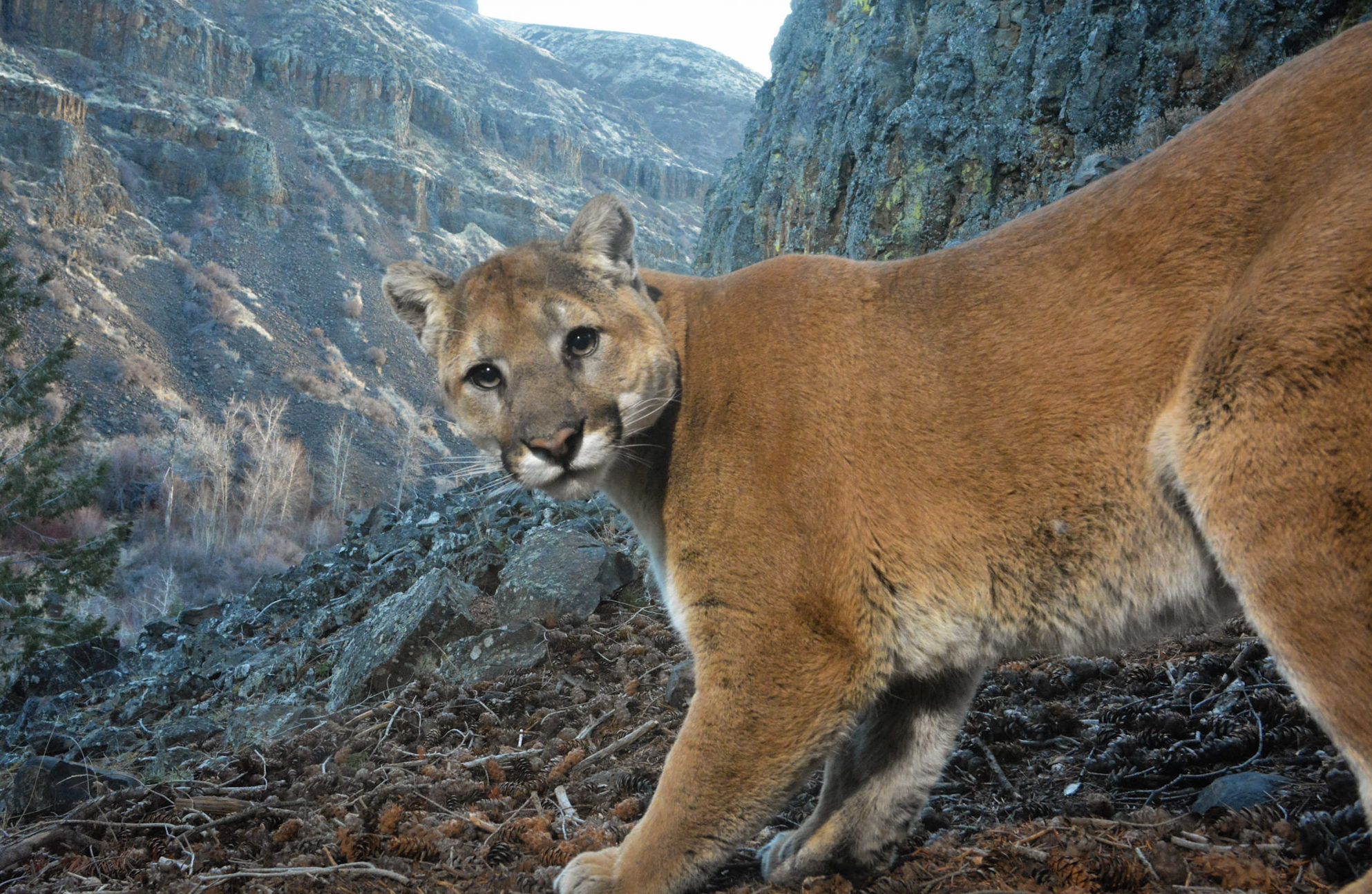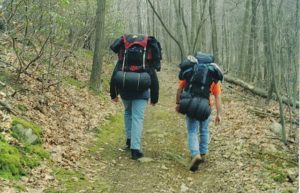Coexistence Navigation:
What Is Coexistence?
On The Range
At The Homestead
In Your Backyard
On The Trail
Respecting Grazing Operations
For Pet Owners
On The Trail – Overview
Whether you are hiking, mountain biking, or simply out for a stroll, it’s always a good idea to be respectful of any mountain lions that may be around. Mountain lions are most active at dawn and dusk, so you can respect their space by avoiding those times. To alert mountain lions to your presence, consider hiking in groups, making noise and wearing bright or contrasting clothing. In general, pay attention to your surroundings. Avoid wearing headphones, and check out social media posts about a park or trail before you visit. When going out with pets or children, keep them close and don’t let them wander out of sight. Pets should always be leashed, and consider extra steps like light-up collars and GPS clips.
No matter what wildlife you encounter, give them space, and do NOT approach, film, or follow. If you encounter a mountain lion, remember to Appear Large, Be Loud, Make Eye Contact, Back Away Slowly, and If Attacked, Fight Back. Finally, it’s important to remember that the mere presence of mountain lions near a trail should not be cause for fear or alarm. We are in their habitat, and they are inclined to avoid us, especially when we take these steps.
Being Respectful Of Wildlife And Avoiding Encounters

Understand mountain lion biology and behavior –Encounters with mountain lions are rare, but when people hike or bike in mountain lion habitat, understanding the biology and behavior of the species is important for mutual safety and respect. Mountain lions tend to spend the day in dense cover, and to hunt when deer are active, most often at dawn and dusk. These late and early hours of the day are also times when people like to be outside, so we have a responsibility to be aware of our surroundings when recreating during these times. Additionally, rapid movement like running or biking may trigger a lion’s instinct to chase. When engaging in these activities and, consider the terrain, bring an air horn with you and be prepared to stand your ground and dissuade a lion from continuing to pursue you. Above all, remember that the key to safety is to be aware; not afraid.
Stay aware of your surroundings – Many encounters with wildlife occur when people are not paying attention and accidentally stumble upon an animal. Staying attentive to your surroundings can prevent this from happening. Remove headphones so you can hear, and periodically check around you, especially before entering places with dense brush or low visibility. It’s also a good idea to check trail signage or social media posts about a trail before you go. That way, you know what wildlife to expect and can stay apprised of any recent encounters.
Alert wildlife to your presence – Wearing bright and contrasting colors can be helpful for rescuers to locate you if you become lost, and can make sure hunters identify you as human. While mountain lions do not see color like humans and are more attracted to movement, wearing bright and high-contrast clothing can help signal that you are not their prey. Additionally, making noise, such as by talking or singing, can also help mountain lions know you are coming so they can stay out of your way. This is made easiest by going hiking in groups so that your chatting and commotion alerts wildlife to your presence.
 If you run across a dead animal in the brush, steer clear – Don’t investigate or disturb an area with a dead animal. Mountain lions cache their prey for weeks at a time, and will return to the cache to eat. They depend on their cache for survival, as do many other wildlife species. While lions have been shown to abandon their caches in human presence, and even when they hear recorded human voices, a desperate lion may be defensive of their cache. The best thing you can do to be a good neighbor is move on and not disturb feeding sites.
If you run across a dead animal in the brush, steer clear – Don’t investigate or disturb an area with a dead animal. Mountain lions cache their prey for weeks at a time, and will return to the cache to eat. They depend on their cache for survival, as do many other wildlife species. While lions have been shown to abandon their caches in human presence, and even when they hear recorded human voices, a desperate lion may be defensive of their cache. The best thing you can do to be a good neighbor is move on and not disturb feeding sites.
Keep pets leashed – It’s important to keep pets on a leash, and to keep them close to you so they don’t accidentally stumble upon or chase wildlife. It’s easy to see how a dog could be mistaken for prey, and chasing a pet may bring the mountain lion back to you. For the safety of you, your pets and your local wildlife, it’s best to keep pets leashed.
Never approach wildlife – It’s not safe to approach or attract any wild animal. This is not only true for mountain lions, but all species. For example, deer kill and injure MANY more people per year than mountain lions do, so even wildlife that seem harmless like herbivores should be avoided.
If You Encounter a Mountain Lion
Understand mountain lion body language – If you encounter a mountain lion and it doesn’t run from you immediately, don’t jump to conclusions about the meaning of its behavior. If it is watching you, it may simply be curious, or it may even view you as a predator. Lions will not turn their back on you if they view you as dangerous, because they know from their own hunting behavior that predators attack from behind. So, a lion not backing down is often a sign that you already have the advantage.
Be intimidating, and give them a way out – Predators, like the mountain lion, cannot afford an injury. If they are hurt, they cannot hunt effectively, defend a territory, or seek water and shelter. When injured, wild animals starve. Additionally, research has shown that mountain lions go out of their way to avoid humans. This fear is healthy and should be encouraged, for their own safety and yours. Therefore, the best way to ensure that both you and the lion may leave safely is for you to intimidate the mountain lion and give it the opportunity to escape. You can do that by taking the following steps.
BE as large as possible – Make yourself appear larger by raising your arms, opening up your jacket and picking up children or pets (which also keeps them from panicking and running). If you are with others, stand close together.

Make noise – Yell, shout, bang your walking stick or water bottle, and call for help, both to intimidate the lion and to alert others. In one case a 9-year-old boy frightened a mountain lion away by playing his trumpet. When asked why he did that he said, “…my parents taught me to make noise, look big, do not run…”

Make Eye Contact – Maintaining eye contact shows the lion that you are aware of its presence and not afraid. Never run away from a mountain lion, bend over, crouch down or do anything to break eye contact.

Slowly create distance – Assess the situation. Consider whether you may be between the lion and its kittens, prey or cache. If you have a clear path to retreat, back away slowly in that direction to create distance, giving the lion the opportunity to retreat.

Protect yourself – In the very rare situation that you are attacked, fight back. Protect your neck and throat. People have used rocks, jackets, garden tools, tree branches, walking sticks, fanny packs and even bare hands to turn away mountain lions.


Consider why a mountain lion might behave aggressively – It’s important that a lion not feel cornered, or separated from its kittens, or a cached kill. If a lion doesn’t take an easy exit, kittens or a cache may be the reason. This was likely the case during a recent encounter in Utah when a hiker came across mountain lion kittens on a trail. The mother followed the hiker as he backed away slowly, yelled at her and remained large. The lion even made some “bluff charges” to encourage the hiker to keep moving backwards. However, once the hiker was far enough away, the mother turned and fled back to her young.
A note about throwing things – Throwing rocks or sticks at a mountain lion shows you mean business. Not only does being hit by a thrown rock hurt, but it makes it very clear to the mountain lion that you are not their prey. However, make sure that picking up a rock doesn’t cause you to break eye contact or stoop into a vulnerable position.
While It May Be Tempting – Do NOT Record Encounters
Trying to take pictures or video during a mountain lion encounter is never advised. When attempting to get footage, your attention is diverted from getting out of the encounter as safely and quickly as possible. It’s also challenging to appear large, wave your arms or throw things when your hands are occupied by a phone or camera. Additionally, making a media event out of a mountain lion encounter often leads to the death of the lion, even when it behaved perfectly naturally and caused no harm. Some people will rush to the area in hopes of seeing the lion. Others will demand — out of fear — that the danger be eliminated. So, if you see a lion in the wild, consider your safety and that of the lion, and be grateful for the rare opportunity. Many people work their whole lives in the wild and never catch a glimpse of this elusive creature.
How Public Land Managers Respond to Mountain Lions
Most public land managers and wildlife officials do not consider the presence of mountain lions to be a risk to people – With much of the western United States being mountain lion habitat, many parks have come to expect occasional lion sightings as natural occurrence in wild areas, and will simply take note of your report of seeing a lion. If the lion exhibited aggressive behavior in the encounter, officials may close off the trail temporarily as it may be a mother lion with cubs nearby; or they may choose to investigate why the lion behaved out of character, as it may be diseased or injured.
Consider this statement from the California Department of Fish & Game:
 “DFG does not consider mountain lion sightings near human habitation a public safety concern as long as the lion is not exhibiting aggressive behavior towards people. Mountain lions occur most anywhere you can find their primary prey, which is deer. As you likely know, deer not only live in remote forests, but also in green belts, parkways and riparian corridors along rivers. As such, mountain lion sightings in these areas are not uncommon, and DFG receives numerous reports of lions in these settings every month. Mountain lions are considered beneficial in these settings as they maintain healthy deer herds by keeping their populations in check.
“DFG does not consider mountain lion sightings near human habitation a public safety concern as long as the lion is not exhibiting aggressive behavior towards people. Mountain lions occur most anywhere you can find their primary prey, which is deer. As you likely know, deer not only live in remote forests, but also in green belts, parkways and riparian corridors along rivers. As such, mountain lion sightings in these areas are not uncommon, and DFG receives numerous reports of lions in these settings every month. Mountain lions are considered beneficial in these settings as they maintain healthy deer herds by keeping their populations in check.
DFG has scientific evidence that mountain lions inhabiting areas close to humans are no real cause for concern. We have either conducted or been associated with mountain lion studies that have monitored their movements in such areas. We typically capture mountain lions and place a radio collar on them in order to track their movements. The information gleaned from these collars has provided some illuminating results. They have indicated that mountain lions regularly use such areas more frequently than we have previously thought, and that these lions generally attempt to stay away from people.
For example, in Southern California, university researchers have placed collars on these big cats in a heavily used park. They also placed trail loggers and remotely triggered cameras along popular trails to estimate human use. Surprisingly, the results indicated that some lions were mere feet away from people who were unaware of the lion’s presence. During the course of this study, no reports of aggressive lion behaviors were ever reported to the researchers or park personnel.”
Excerpt from Outdoor Magazine
California Dept. of Fish & Game, May, 2012



